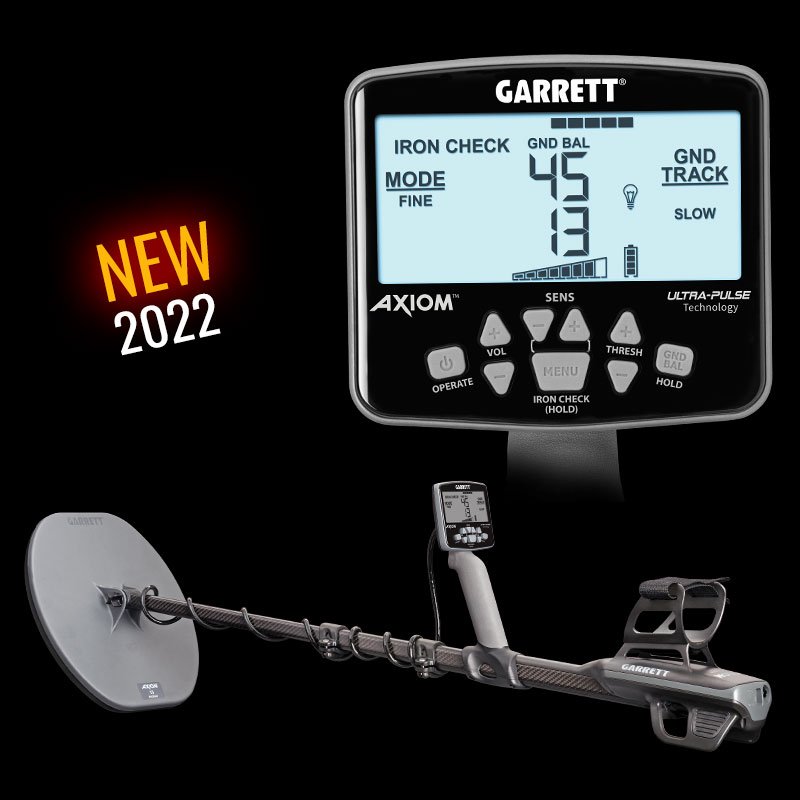
| Alkaline | Non rechargeable battery recommended for most detectors by the manufacturers |
|---|---|
|
All Metal |
A setting available on some detectors allowing them to detect any kind of metal (ferrous or non-ferrous) |
| Artefacts | Man-made objects found whilst detecting. We normally refer to buckles, buttons, musket balls and other finds, but not coins. |
| Audio ID | This is available on a number of detectors to identify a target by an audible tone. |
| Black sand | Negative ground minerals consisting of magnetic iron oxide. This can be found either inland or on the beach. This will result in a loss of depth for the detector. |
| Chatter | ‘Noise’ or broken signals caused by ground minerals or small pieces of iron. To overcome this reduce sensitivity or slightly increase discrimination. |
|
Coil (Search Coil) |
The part of the detector that senses the target. This is sometimes known as ‘search head’ ‘loop’ & ‘antenna’ |
|
Coin depth |
On some detectors the coin depth facility gives an indication of the depth of the target. |
|
Concentric |
Search coil with two circular coils tuned to each other to produce a cone shaped search matrix, (see coils). |
|
Control box |
Contains the circuitry controls, speaker, usually the batteries and the microprocessor. (Not always in the middle of the machine. |
|
Cut back |
Loss of depth caused by mineralized soil. Also occurs on wet sand on tidal beaches. |
|
Depth |
Simply how deep your find is from the surface. |
|
Detector |
Informal term for a metal detector |
|
Detectorist |
Everyday term used to describe a person who uses a metal detector. |
|
Digger |
Or trowel, spade, or any tool used to dig for your finds. Various different trowels are available designed specifically for the hobby. They come in many different shapes and sizes to suit all budgets. |
|
Discrimination |
A facility on most modern detectors to enable the user to ignore unwanted items. This can normally be set manually at a level no higher than ‘iron’ as there may be a chance good items become rejected with the junk. |
|
Double D |
Also known as wide scan. This is a type of search head containing two balanced D shaped coils |
|
False signals |
These can be caused by junk, loose leads on the coil, stubble or hard soil. |
|
Ferrous |
Objects made from iron. |
|
Frequency |
The Hertz measurement of current cycles in the metal detector. |
|
Ground balance |
The point at which the detector neutralizes ground minerals and finds targets easier. |
|
Ground effect |
Positive or negative mineralization in the ground causing loss of depth on the detector. |
|
Ground reject |
Ability of the detector to overcome ground effect. |
|
Grot |
Usually Roman or Georgian bronze or copper coins worn & corroded. |
|
Hammered |
A hand made coin struck between dies from a metal blank. Normally silver or gold. |
|
Hoard |
A collection of coins or valuable items buried for safe keeping but never retrieved. |
|
Hot rock |
A single rock that is higher in minerals than those in the surrounding area. |
|
Masking (Target Masking) |
A good find hiding behind junk resulting in a mixed signal. |
|
Mineralization |
Naturally occurring minerals in the ground causing loss of depth and an erratic performance. |
| Motion | The movement of the search coil to detect finds. Most modern detectors are motion detectors. |
| Negative mineralization | Ground contamination and loss of depth usually consisting of small particles of iron or ferrous minerals occurring naturally in the soil. |
| Nicad | Type of rechargeable battery. Nickel-Cadmium |
| Non motion | First developed in the 1960’s. They need to be manually tuned and re-tuned every few minutes due to the signal drifting. |
| Pinpoint | A feature on most detectors to enable the user to pinpoint the target. |
| Positive Mineralization | Normally found on salt wet beaches. Often causes a detector’s threshold to increase |
| PI (Puls Induction) | Pulse induction is a type of metal detector which is able to ignore mineralization, often used for searching the wet salty sand on beaches. |
| Reject | The ability of a metal detector to ignore unwanted targets. Also known as discrimination. |
| Search head | Often referred to as a coil, antenna or loop. (See coil) |
| Sensitivity | The depth at which a metal detector can register metal objects. Full sensitivity can be used for best depth but, is not recommended. It is often beneficial to turn the sensitivity down in order to match the conditions of a site. |
| Scattered Hoard | A collection of buried coins which have been scattered or disturbed by ploughing |
| Signal | The audio sound given off by the metal detector when it passes over a metal item |
| Scuff cover (Coil cover) | Protective plastic cover which fits on to the underside of the coil. The coil cover should remain on the coil during use to prevent scratches and damage to the coil. It is cheaper to replace a coil cover than it is to replace a searchcoil so these are highly recommended. |
| Silent search | Modern detectors run with a silent threshold except when passed over a metallic object. |
| Stability | The detector’s stability is its ability to maintain threshold without drifting out of tune. Instability can also result from outside electric interference such as power lines or from chatter created by small pieces of iron on mineralized ground. |
| Stem | Also referred to as the shaft, (upper and lower). This is the tubular section of metal connecting the coil to the rest of the detector |
| Sweep | The metal detector sweep is the movement of the coil along the floor when searching for treasure. Often side to side as the detectorist is moving forwards. |
| Target | The object in the ground which causes the detector to give a signal. |
| Target Masking | This is when a good find is hidden behind a bad find. (See Masking) |
| Threshold | Most modern metal detectors do not need to be tuned in and run on a silent threshold. The threshold is the optimum point of tuning on a detector where a faint tone can be heard. |
| Tone Discrimination | When a metal detector has the ability to let the user know if the target is good or bad. A different tone can be heard for different types of metal. |
| Trash | Junk, Rubbish, unwanted metallic finds like rusty old nails, silver paper, drink cans. |
| Treasure trove | This has since become the treasure act 1996. The ancient law which states that precious metal objects, hidden with the intention of being retrieved later become the property of the crown. |
| Treasure | Items covered under the treasure act. |
| Tune | The adjustment required to set a detector up to its best performance. |
| Variable discrimination | This is a control on many modern metal detectors which allows the level of junk rejection to be modified by the user. |
| Visual I.D. | Where the detectorist uses the meter of a detector to indicate the possible nature of the target. |
| Widescan | Double D or 2D coils capable of finding a target across the diameter of the coil |

